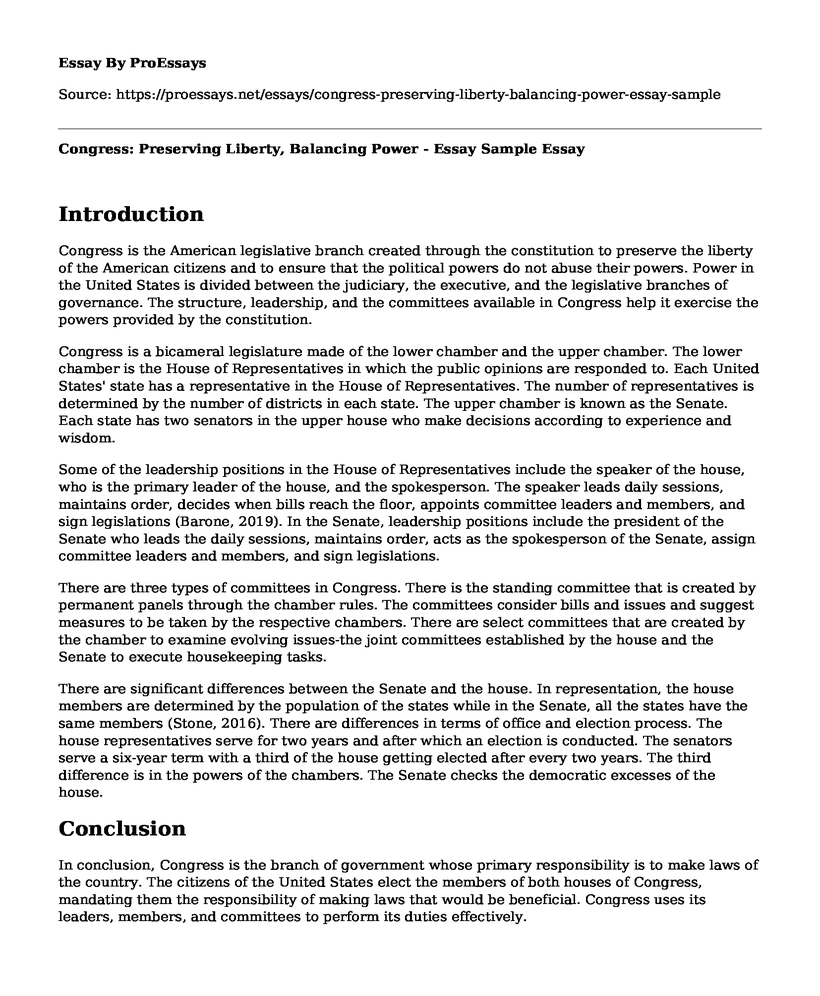Introduction
Congress is the American legislative branch created through the constitution to preserve the liberty of the American citizens and to ensure that the political powers do not abuse their powers. Power in the United States is divided between the judiciary, the executive, and the legislative branches of governance. The structure, leadership, and the committees available in Congress help it exercise the powers provided by the constitution.
Congress is a bicameral legislature made of the lower chamber and the upper chamber. The lower chamber is the House of Representatives in which the public opinions are responded to. Each United States' state has a representative in the House of Representatives. The number of representatives is determined by the number of districts in each state. The upper chamber is known as the Senate. Each state has two senators in the upper house who make decisions according to experience and wisdom.
Some of the leadership positions in the House of Representatives include the speaker of the house, who is the primary leader of the house, and the spokesperson. The speaker leads daily sessions, maintains order, decides when bills reach the floor, appoints committee leaders and members, and sign legislations (Barone, 2019). In the Senate, leadership positions include the president of the Senate who leads the daily sessions, maintains order, acts as the spokesperson of the Senate, assign committee leaders and members, and sign legislations.
There are three types of committees in Congress. There is the standing committee that is created by permanent panels through the chamber rules. The committees consider bills and issues and suggest measures to be taken by the respective chambers. There are select committees that are created by the chamber to examine evolving issues-the joint committees established by the house and the Senate to execute housekeeping tasks.
There are significant differences between the Senate and the house. In representation, the house members are determined by the population of the states while in the Senate, all the states have the same members (Stone, 2016). There are differences in terms of office and election process. The house representatives serve for two years and after which an election is conducted. The senators serve a six-year term with a third of the house getting elected after every two years. The third difference is in the powers of the chambers. The Senate checks the democratic excesses of the house.
Conclusion
In conclusion, Congress is the branch of government whose primary responsibility is to make laws of the country. The citizens of the United States elect the members of both houses of Congress, mandating them the responsibility of making laws that would be beneficial. Congress uses its leaders, members, and committees to perform its duties effectively.
References
Barone, M. (2019). Will Congress have to learn to write laws again?. Washington Examiner. https://www.washingtonexaminer.com/opinion/will-congress-have-to-learn-to-write-laws-again/
Stone, L. (2016). Want To Fix Congress? Add 5,500 New Representatives. The Federalist. https://thefederalist.com/2016/03/14/want-to-fix-congress-add-5500-new-representatives/.
Cite this page
Congress: Preserving Liberty, Balancing Power - Essay Sample. (2023, May 11). Retrieved from https://proessays.net/essays/congress-preserving-liberty-balancing-power-essay-sample
If you are the original author of this essay and no longer wish to have it published on the ProEssays website, please click below to request its removal:
- A Policy for the Americans With Disabilities Act (ADA) Essay
- Macroeconomic Policy Lessons From the Financial Crisis Paper Example
- Marxist Criticism on Mary Shelley's Frankenstein Essay Example
- Literary Analysis Essay on After the Arab Spring
- Dystopias in Media as a Form of Propaganda Essay Example
- NASA Investment: Essential for America's Superpower Status - Essay Sample
- Essay Example on Policy Measures to Protect Working-Class Group from Tuberculosis







